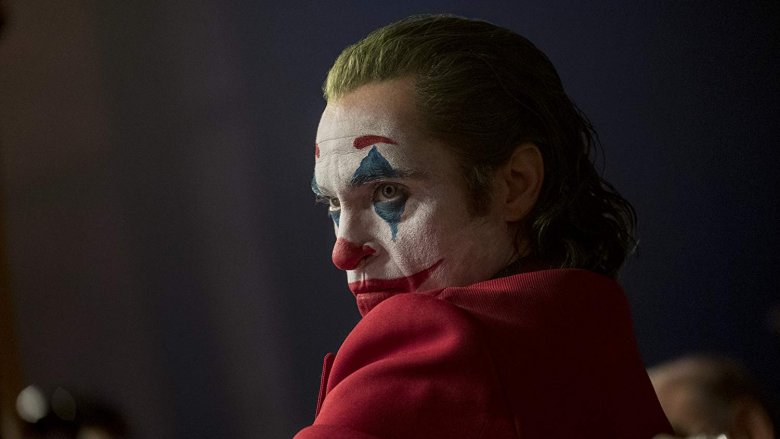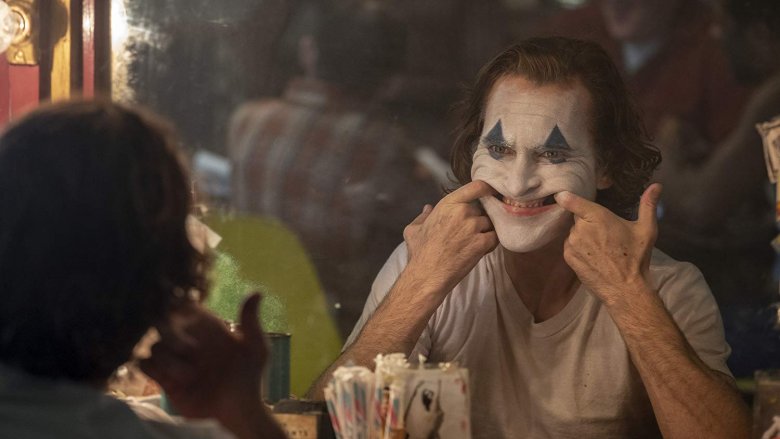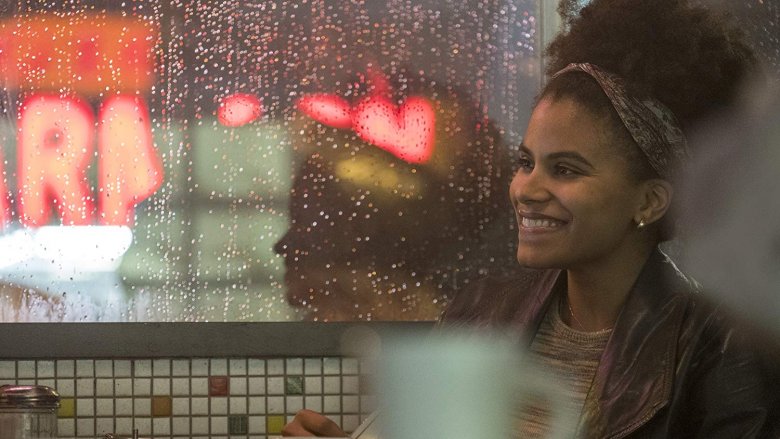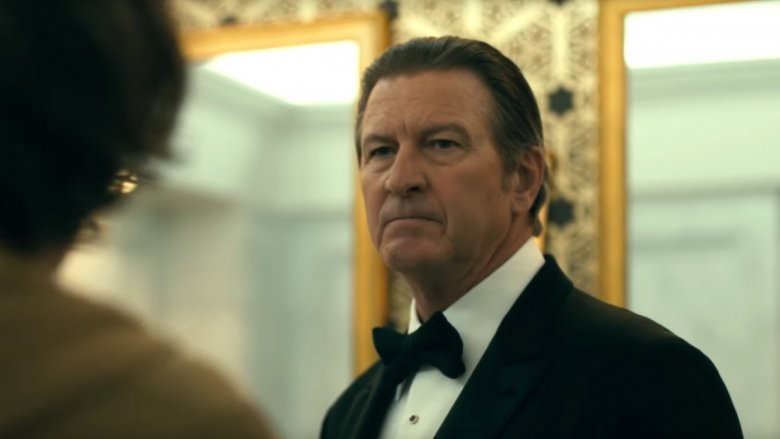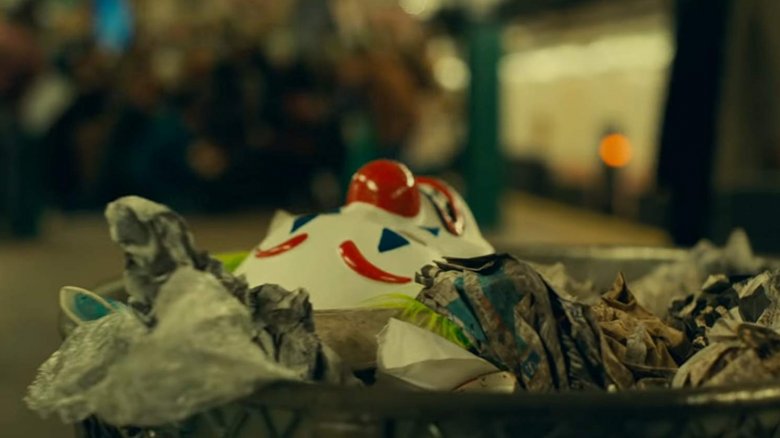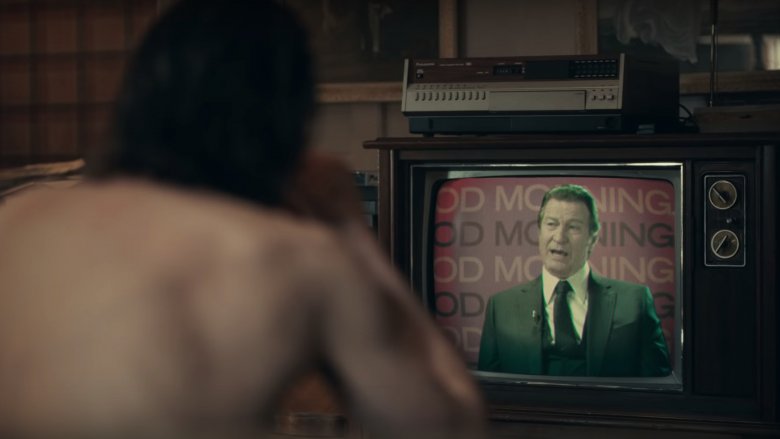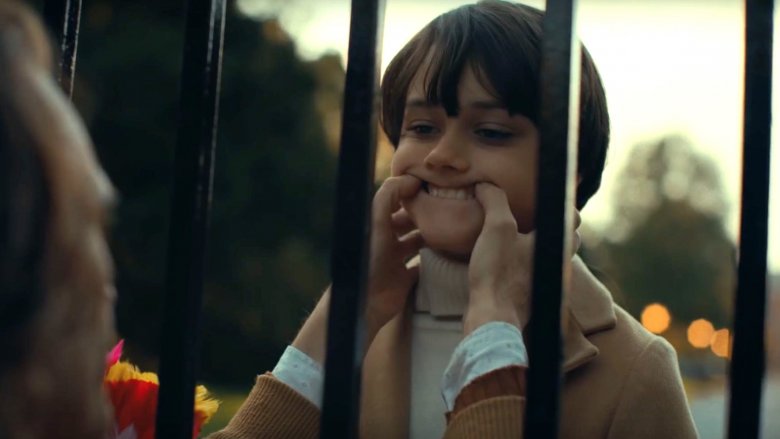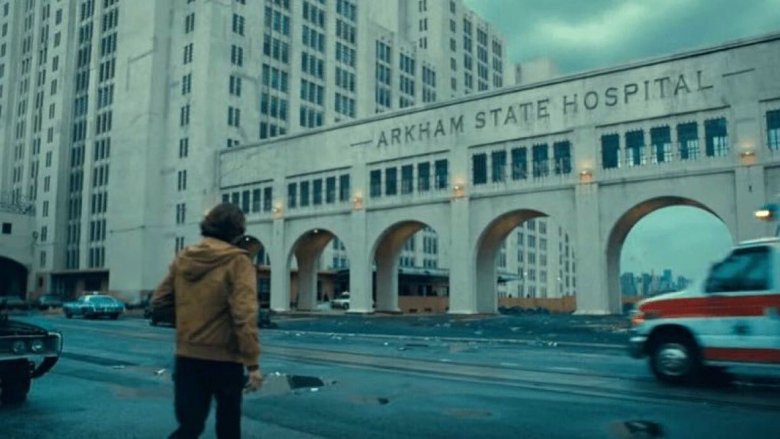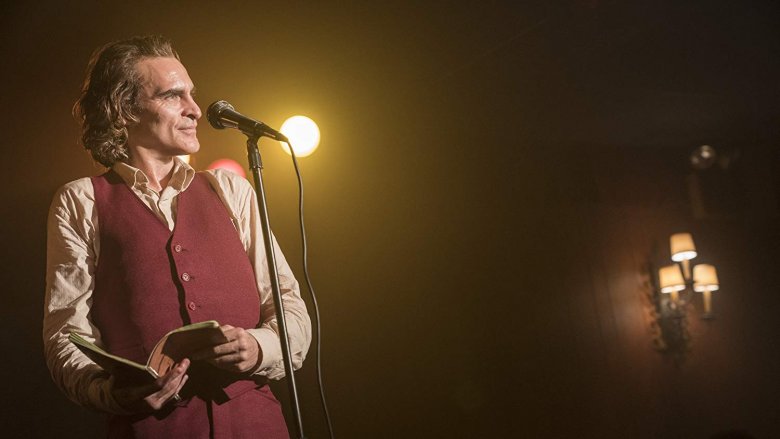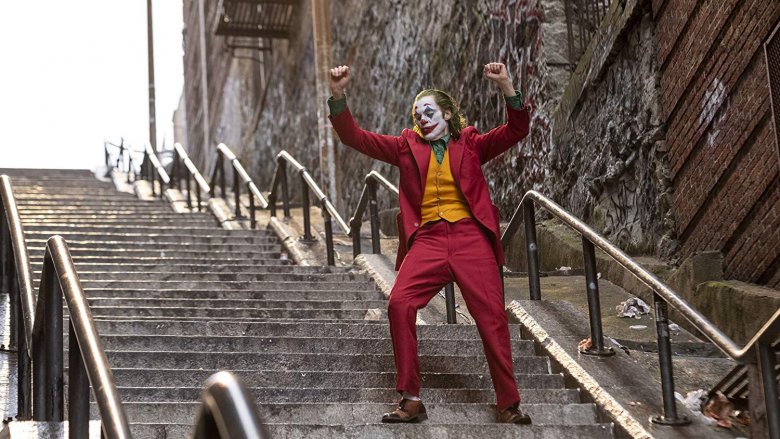The Ending Of Joker Explained
Joker, the controversial R-rated take on the DC Comics villain that has become one of the most anticipated films of 2019, is finally here, giving moviegoers everywhere the chance to buy a ticket and see for themselves if the film was really worth all the hype. Whether or not you come out of the theater liking it, it's hard to deny the impact Joker has had in various pop culture spheres, and it's not a topic of conversation that's likely to go away anytime soon. The film, directed by Todd Phillips and starring Joaquin Phoenix in the title role, definitely goes its own way with the depiction of the legendary Clown of Prince of Crime, right up to its explosive and unforgettable climax. Now that everyone's had a chance to see the film, it's time to talk about what it all built to and how it all paid off. This is the ending of Joker, explained. SPOILERS AHEAD for the entire film!
Arthur Fleck's future
The whole of Joker is about the transformation of Arthur Fleck from downtrodden, beat-up loser to hero in his own mind, so obviously the biggest set of implications to unpack in the film's ending concern him. The last time we see Arthur he's walking out of an interview room in Arkham State Hospital, fresh off the triumph of the night he shot Murray Franklin in the head and became the figurehead of an entire riotous movement.
We see that Arthur's shoes are bloody as he walks down the hall, and then we see an orderly chasing him down the corridors as he seems to be laughing with glee, suggesting a violent escape might be in order for the newly minted Clown Prince of Crime. This is interesting because we've already seen Arthur break free from custody once, after the police car he was riding in was plowed into by a rogue ambulance driver, and now he seems primed to make a break for it once again. Is there a plan at work? Are there members of a new Joker Gang waiting outside of the hospital to help facilitate his getaway? Even if there aren't, it's clear that Arthur Fleck has long since passed the point of no return, and he'll keep up his reign of chaos for as long as he physically can.
What happens to Sophie?
One of the most important structural aspects of Joker is just how small Arthur's inner circle is. He has his mother, of course, and he seemingly has friends at the clown company until they begin to turn on him, but apart from them the only major presence left (apart from Murray Franklin, who for most of the film exists only on the TV screen) is Sophie, his neighbor who we actually know less about than some parts of the film would have us believe.
In Arthur's mind, Sophie is his girlfriend, at least until she isn't. In Sophie's mind, Arthur is just the slightly strange neighbor she and her daughter ride the elevator with sometimes. When he walks into her apartment uninvited and we discover his fantasy life with her, she is clearly scared but also eager to defuse the situation. By the time the dust has settled (if it ever really settles), she manages to escape Arthur's reign of terror with her life.
So, what becomes of Sophie? Well, we barely know anything about her to begin with, so it's hard to say. What is clear, though, is that the police will soon be finding a brutally murdered body in Arthur's apartment, so they'll probably be knocking on her door to ask questions, at which point she'll discover just how lucky she was.
The Gotham mayoral race
Penny Fleck's obsession with Thomas Wayne, and Wayne's own on-camera campaign to clean up Gotham City by running to be the city's next mayor, is a subplot that runs throughout Joker, and adds to the powder keg that is the film's climax as Wayne grows increasingly frustrated with the protestors that begin popping up all over the city in the wake of Arthur's subway murders. By the end of the film, Thomas Wayne is dead, a consequence of unwittingly walking right into the middle of the Joker riot and being recognized alongside his wife and son.
Wayne may be gone, but the Gotham mayoral race will no doubt move forward without him, because the city has to have a mayor. His death will no doubt send shockwaves through the city, and whoever runs for mayor in his place will find their face completely transformed by his loss. The next Gotham election, whenever it is, will inevitably be about the fallout from Thomas Wayne's murder and the circumstances which led to it, and whoever wins will be responsible for charting a new course for Gotham through very stormy waters that threaten to drown the city.
The future of the Joker Gang
Throughout the film, as Arthur goes through his own deeply personal descent into violent, vengeful madness, a massive groundswell of support for him is building right under his nose. Near the end of the film, Arthur promises Murray Franklin that he's apolitical, and that he has nothing to do with the protestors who've adopted clown masks in solidarity with the then-anonymous subway shooter, but he's clearly pleased by the idea that people have begun to idolize him in some way. By the end of the film Arthur has fully embraced the people who have become his followers, standing up among them as a leader for one triumphant moment before the film cuts to him in Arkham.
So whether Arthur stays in Arkham State Hospital or not, the Joker Gang will not simply calm down and go home. They might dissipate, or relax their protests a bit and eventually fade out, but that doesn't just go away because the Joker is in jail. The gang is still out there, and they might still be causing vast amounts of chaos.
Thomas Wayne's secrets
Arthur's explorations of his mother's true motives as she spends much of the film obsessively writing letters to Thomas Wayne take him on an emotional rollercoaster. He initially only sees Wayne as his mother's former employer, then realizes that Penny Fleck is writing Wayne letters on behalf of Arthur, who she claims is his son. Thomas Wayne and his butler Alfred vehemently deny this, and Arthur later seemingly confirms their denials after stealing his mother's records from Arkham and confirming that he was adopted. But is that the whole truth?
After he kills his mother, Arthur finds an old photo of her with an inscription on the back admiring her smile, signed by "T.W." So perhaps Thomas Wayne is not Arthur's father, but had an affair with Arthur's adoptive mother? Perhaps his negligence created problems for Penny Fleck in the first place? Perhaps investigations following his death will reveal such things? We can't say for sure, but that little inscription suggests that there's more to the story than those Arkham files had to offer.
The future of Bruce Wayne
Joker spends much of its runtime dodging rather than actively embracing potential comic book connections, to the point that Arthur spends a lot of his time judging his mother for paying so much attention to Thomas Wayne, a man he feels is unjustly praised simply for being rich. When the comic book connections do kick in, though, they lead down a dark path, a chain reaction started by Arthur that ends in the murder of Thomas and Martha Wayne, who are gunned down by a clown-masked rioter in an alley.
One of the final images of the film is Bruce Wayne standing alone in that same alley, the corpses of his parents on either side of him. It's an image that Arthur laughs at, and the film suggests that he'll hold onto that image going forward as Bruce Wayne grows up, setting up the obvious Batman vs. Joker confrontation between the two characters. The big question that the film doesn't answer, though, is how watching his parents get gunned down specifically by a dude in a clown mask will end up changing Bruce. Batman is usually depicted as a guy who fights criminals in general, but this version of Bruce might end up having a very specific agenda on his hands when he's all grown up, one that would fundamentally alter the Dark Knight as we know him.
The rise of Arkham Asylum
One of the film's iconic Gotham City locations is a new variation on Arkham Asylum, which the film dubs "Arkham State Hospital." As the name suggests, it's not an ornate mansion that houses lunatics, but rather a drab, grimy hospital where the violently insane people (and sometimes people who just don't know where else to go) are housed. By the end of the film, it also happens to be the home of the Joker, who quickly cements his violent reputation by killing his own therapist.
While the name won't necessarily change because Arthur Fleck happens to be in custody there, the ending of Joker feels like a symbolic change in which this drab mental hospital becomes home to the most feared man in Gotham, thereby becoming a version of the Arkham we all know. Perhaps, just as Batman seems to draw out a certain type of criminal to fight him, Joker will draw a certain type of murderous weirdo to the asylum, and then it'll really feel like the Gotham we know.
Fantasy bleeding into reality
Very early on in Joker, when Arthur goes home to relax in front of the TV with his mother at the end of the day, we see the first traces of the fantasy life he leads as he imagines himself in the studio audience of Murray Franklin's show. Later, the film shows us that this fantasy can go much, much deeper, as we see an entire imagined romantic relationship between Arthur and Sophie that culminates in him wandering into her apartment at the end of a bad day.
This is all important because it emphasizes just how lonely Arthur is. He has to imagine companionship, adoration, and celebrity because his real life just doesn't seem to support such things. It's also important because it forces us to contend with the possibility that at least some of what Arthur does during the film's climax didn't actually happen. Was he really carried out of the cop car by his followers after the crash? Did he really murder his therapist? Does it go deeper? Was he really in the asylum the whole time, just imagining all of this? These are questions that encourage repeat viewing of the film, to see just how many details we can pick out that point the reality or fantasy of each scenario.
The future of the Joker
Joker is, among many other things, the origin story for a villain, even if it's not the same version of the villain we're used to seeing on the comic book page or even on the big screen. Arthur Fleck is, by the end of the film, directly asking people to call him Joker, and drawing a big smile on his face in his own blood seems to seal the deal. He's the Joker now.
This cemented sense of a new identity is interesting for a number of reasons, not least of which is the fact that everyone knows this version of the Joker's real name. He's a man wanted by the police who ends up getting arrested at the end of the film, and he went on live TV and let Murray Franklin call him "Arthur." There is no mystery over the Joker's identity this time around, so how can we reconcile him with the comic book version? Well, the short answer is we don't have to, but if you're really interested in digging that deep (And hey, why not?) there are a couple of possibilities. One is that this is just another version of the many fake origin stories that Joker likes to throw around to confuse people. The other is that Arthur Fleck is not the only "Joker," and that one day (perhaps when Bruce Wayne is all grown up), a mystery man will adopt the moniker with Arthur as the inspiration.
